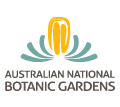 |
In Flower This WeekA weekly news-sheet prepared by a Gardens volunteerNumbers in brackets [ ] refer to garden bed 'Sections'. Plants in flower are in bold type. |
 |
In Flower This WeekA weekly news-sheet prepared by a Gardens volunteerNumbers in brackets [ ] refer to garden bed 'Sections'. Plants in flower are in bold type. |
16 November 2001
Just outside the Visitor Centre doors, on the left as you turn onto Banks Walk, notice the many flower spikes on the Wedding Lily, Dietes robinsoniana [Section 210], which are about to burst into flower. So plan to visit the Gardens again when they are in full and glorious bloom!
Walk along Banks Walk and admire the cascading pink and white flowers of Leptospermum polygalifolium [Section 210] as well as the fine red blooms of Anigozanthos ‘Bush Sunset’ [Section 210]. Notice also the interesting flowers of a sedge, Carex gunniana [Section 210], growing at the edge of the pool. Just to the right of the waterfall you can see Helichrysum ‘Helping Hand’ [Section 210], the floral emblem of the International Year of Volunteers, which is for sale at the Botanical Bookshop in the Visitor Centre.
Cross the bridge over the Rainforest Gully, pass the Café, then a bit further on, veer from the Main Path to the right into the Myrtaceae section. The family Myrtaceae dominates the Australian vegetation with about 1700 species and includes the eucalypts, bottlebrushes, tea-trees and paperbarks. On the left, at the beginning of Section 12, are several specimens of Kunzea ambigua [Section 12] covered with fragrant cream flower balls. Further on are the spreading white flowers of a tea-tree Leptospermum juniperinum [Section 12] contrasting with the silver-grey foliage and red tufted flower heads of the nearby Calothamnus quadrifidus [Section 12]. Called the Common Net Bush, this plant is probably the hardiest shrub of the genus Calothamnus. The graceful weeping specimen of Leptospermum minutifolium [Section 12], behind the ‘Who Lives Here?’ sign, has very small leaves and white flowers.
Further along the road, past the stands of paperbarks on both sides of the path, you will see on the left the beautiful white flowers of Leptospermum scoparium ‘Horizontalis’ [Section 12], next to the path, and, behind, the creamy-yellow flower heads of the shrub Callistemon pallidus [Section 12]. On the right is Callistemon salignus [Section 13], also with cream flower spikes. Turn left to follow the gravel path where you will see the massed cream flowers of the prostrate form of Kunzea ambigua [Section 12], then turn right into the Asteraceae (daisies) section. The third largest family of flowering plants in Australia, daisies are widespread in most habitats.
On the right are cheerful bright yellow flowers of Yellow Buttons, Chrysocephalum apiculatum (sens. lat.) [Section 29], contrasting with the silvery-grey hairy leaves. Directly opposite are the small yellow flowers of Ixiolaena leptolepis [Section 29], a widespread species. Further along the loop path, next to a large specimen of Eucalyptus nitens, are stands of Senecio garlandii [Section 29] displaying their vivid yellow daisy flowers.
Walk around this section and admire and enjoy the infinite variety of the cheerful daisy family.
Elizabeth Bilney
Elizabeth Bilney
| Return to: | Australian National Botanic Gardens | Previous
'In Flower' Weeks |